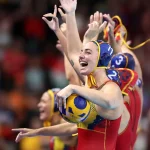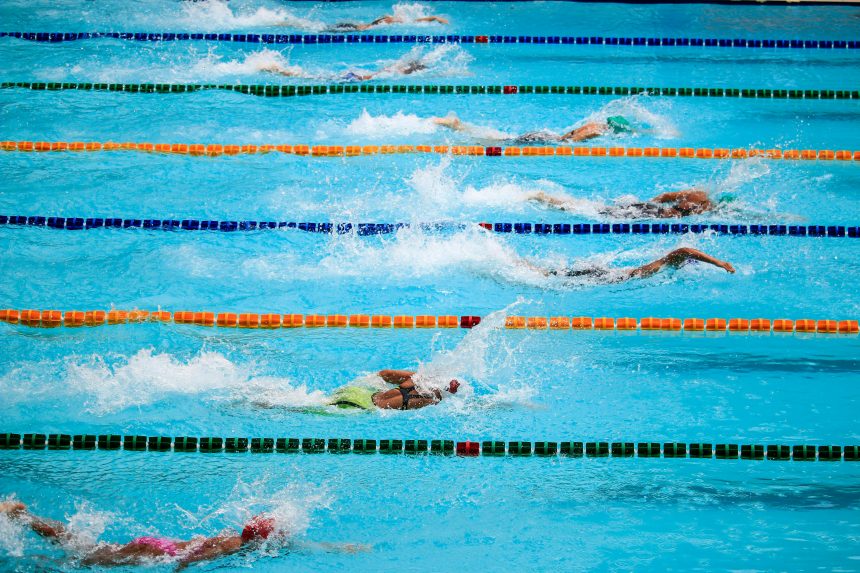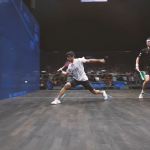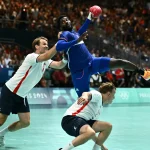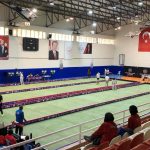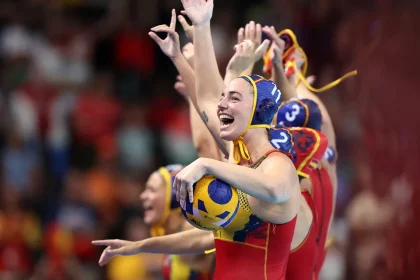Competitive swimming is a sport where athletes race against each other or the clock in a pool, open water, or controlled aquatic environment, aiming to complete a set distance in the shortest time. It encompasses four main strokes—freestyle (front crawl), backstroke, breaststroke, and butterfly—plus the individual medley (IM), which combines all four. Races vary in distance (50m to 1500m in pools, up to 10km in open water) and format (individual, relay, or mixed relay). Pool events occur in 25m (short course) or 50m (long course) pools, with electronic timing systems ensuring precision.
Swimmers wear swimsuits (e.g., tech suits for elites, costing ~USD 100–500), goggles, and caps to reduce drag and improve visibility. The sport demands endurance, strength, technique, and mental focus, burning ~500–800 calories per hour depending on intensity. Governed by World Aquatics (formerly FINA), competitive swimming traces its modern roots to 19th-century England and has been a core Olympic sport since 1896 for men and 1912 for women.
Why is Competitive Swimming Popular in the Global Sports Market?
Competitive swimming’s prominence in the global sports market, part of a USD 862 billion industry in 2025, stems from several factors:
- Olympic and Media Appeal:
- Swimming is a flagship Olympic sport, with 37 events in Paris 2024, drawing massive viewership (e.g., 5.4 billion global Olympic viewers in 2020). Stars like Michael Phelps (23 Olympic golds) and Katie Ledecky (9 golds) captivate audiences, boosting sponsorships and media deals.
- High-profile races, televised on platforms like NBC and Eurosport, benefit from the sports media market’s USD 182 billion valuation (projected 6.8% CAGR to 2030).
- Accessibility and Inclusivity:
- Swimming is open to all ages, genders, and abilities, with categories for youth, masters (25+), and para-swimmers. Pools are widely available in urban areas, and entry costs are low (e.g., USD 50–100 for goggles, suits, and club fees).
- Its low-impact nature suits diverse fitness levels, promoting lifelong participation. Women’s swimming, equal in Olympic events since 2008, drives gender parity.
- Health and Fitness Trends:
- Swimming’s full-body workout aligns with global health consciousness, offering cardiovascular benefits and injury rehabilitation. It’s recommended by health organizations like the CDC for all ages, fueling participation.
- The global fitness market, valued at USD 96 billion in 2023, supports swimming’s growth through community programs and aquatic centers.
- Global Reach:
- World Aquatics oversees 215 national federations, ensuring standardized competitions worldwide. Strongholds like the U.S., Australia, China, and Europe dominate, but emerging nations (e.g., Tunisia’s Ahmed Hafnaoui) expand its footprint.
- The sport’s universality—pools exist in most countries—contrasts with niche sports like cyclocross, enhancing its market share.
- Technological Advancements:
- Innovations like anti-slip starting blocks, wave-reducing lane dividers, and AI-driven stroke analysis (e.g., SwimTech apps) improve performance and fan engagement. Tech suits, though controversial pre-2010, remain a market driver (~USD 1.2 billion swimwear industry).
- Live streaming and data analytics, used in events like the World Championships, align with digital sports trends.
- Youth and Community Engagement:
- Youth programs, like USA Swimming’s 400,000+ members, foster early participation. School and club teams offer competitive pathways, with no “bench time,” ensuring active involvement.
- Community events, like masters meets or charity swims, sustain grassroots interest, unlike sports requiring specialized venues (e.g., fencing).
Despite its strengths, swimming faces challenges: high training costs (USD 500–2,000/year for club fees, travel), limited accessibility in rural or developing areas, and doping controversies (e.g., 2021 Chinese swimmer bans) can dent credibility. Still, its Olympic prestige and universal appeal ensure a robust market presence, with the aquatics segment projected to grow 5.2% annually through 2030.
Important Global Swimming Events
- Olympic Games:
- Held every four years, the Olympics feature 37 swimming events (34 pool, 3 open water). Paris 2024 (July 27–August 9) showcased stars like Caeleb Dressel (USA) and Ariarne Titmus (Australia). It’s the sport’s biggest stage, driving sponsorships and viewership.
- World Aquatics Championships:
- Biennial (odd years), this is the top non-Olympic event, with 42 pool and open water events. Fukuoka 2023 saw records broken by Ledecky and France’s Léon Marchand. Doha 2024 was a key Olympic qualifier.
- World Aquatics Swimming Championships (25m):
- Biennial (even years), held in short-course pools, emphasizing speed and turns. Budapest 2024 highlighted emerging talents like Canada’s Summer McIntosh.
- An annual short-course series (August–November) across multiple cities, offering prize money (~USD 2.5 million total). It attracts elites like Sweden’s Sarah Sjöström for head-to-head racing.
- Mare Nostrum and Golden Lane Series:
- European circuits (May–June) serving as Olympic and World Championship tune-ups. Mare Nostrum (Barcelona, Monaco) draws global stars, while Golden Lane (France) is a regional powerhouse.
- National Championships:
- Events like U.S. Nationals, Australian Trials, or China Nationals are critical for Olympic selection and domestic rankings. They’re accessible entry points for young swimmers.
These events fuel the sports events market (USD 452.79 billion in 2024, 7.2% CAGR to 2030), with swimming’s high viewership attracting sponsors like Speedo and Omega.
How to Get Started in Competitive Swimming and Get Better
Getting Started (Young or Old)
- Join a Swim Club or Program:
- Find a club through national federations like USA Swimming, Swimming Australia, or World Aquatics’ directory (worldaquatics.com). Local YMCAs, community pools, or university programs offer beginner lessons.
- Youth programs (ages 6–12) focus on stroke basics and fun, while masters programs (25+) cater to adults. Expect ~USD 50–200/month for club fees.
- Learn to Swim:
- Basic swimming proficiency is required. Group lessons (USD 10–20/session) teach floating, kicking, and strokes. Red Cross or SwimKids programs are widely available.
- Adults new to swimming can join adult learn-to-swim classes, often at community pools, emphasizing comfort in water.
- Get Basic Gear:
- Beginners need a swimsuit (USD 20–50), goggles (USD 10–20), and a cap (USD 5–15). Avoid tech suits until competing at higher levels. A kickboard (~USD 10) aids drills.
- Clubs may provide equipment for novices. Check secondhand options to save costs.
- Enter Local Meets:
- Sign up for beginner or age-group meets through your club or federation (e.g., USA Swimming’s “C” meets). Entry fees are ~USD 5–10/event. Races start at 25m or 50m, ensuring accessibility.
- Masters swimmers can join U.S. Masters Swimming (usms.org) events, with relaxed rules for novices.
- Understand the Strokes:
- Learn all four strokes, as most meets include freestyle, backstroke, breaststroke, and butterfly. Freestyle is easiest for beginners; breaststroke suits those with less stamina. Coaches guide stroke selection based on strengths.
Becoming Better at Competitive Swimming
- Master Technique:
- Stroke Efficiency: Work with coaches on body position, breathing, and arm/leg coordination. For example, freestyle requires a high elbow catch, while butterfly demands rhythmic timing.
- Starts and Turns: Practice dives (from blocks or poolside) and flip turns to shave seconds. Backstroke and breaststroke have unique turn rules—learn them early.
- Drills: Use pull buoys, paddles, and fins to isolate stroke components. Drills like “catch-up freestyle” improve timing.
- Build Fitness:
- Endurance: Train 3–5 times/week, with sessions (1–2 hours) mixing aerobic sets (e.g., 10x100m freestyle) and recovery swims. Elite swimmers log 50,000–80,000m/week.
- Speed: Add sprints (e.g., 8x25m at max effort) to boost race pace. Interval training (e.g., 4x200m with 30s rest) mimics competition.
- Strength: Dryland workouts (2–3x/week) include core exercises, push-ups, and resistance bands. Swimmers like Phelps used weightlifting for power.
- Compete Regularly:
- Progress from local to regional meets (e.g., USA Swimming’s “B” or “A” meets), aiming for time standards (e.g., Junior Nationals cuts). Each race refines strategy and mental toughness.
- Analyze splits (e.g., 50m breakdowns) to identify pacing errors. Losses highlight areas for improvement, like weak starts or fading finishes.
- Work with a Coach:
- A qualified coach (USD 50–200/month) tailors workouts and corrects technique. Look for USA Swimming or World Aquatics-certified coaches. Group settings are cost-effective; private lessons accelerate progress.
- Elite coaches, like Bob Bowman (Phelps’ mentor), emphasize mental preparation alongside physical training.
- Leverage Technology:
- Use swim apps (e.g., MySwimPro) for workout plans and stroke analysis. Wearables like FORM goggles display real-time metrics (pace, distance). Video analysis (e.g., GoPro footage) refines technique.
- Study race footage of elites (e.g., Ledecky’s distance pacing) on YouTube or FloSwimming.
- Set Goals and Specialize:
- Set short-term goals (e.g., cut 2 seconds off 100m freestyle) and long-term goals (e.g., qualify for nationals). Track times via federation databases (e.g., USA Swimming’s SWIMS).
- Specialize in 1–2 strokes or distances by age 14–16, based on strengths (e.g., butterfly for sprinters, freestyle for distance). Relays and IMs keep versatility.
- Overcome Challenges:
- Training is time-intensive (10–20 hours/week), and costs (club fees, travel, suits) can hit USD 1,000–5,000/year. Seek scholarships (e.g., USA Swimming Foundation) or local sponsorships.
- Burnout is common in youth; balance swimming with school and rest. Masters swimmers should prioritize recovery to avoid injury.
Young vs. Older Athletes
- Young Athletes: Start at 6–8 with swim lessons or pre-team programs, progressing to competitive clubs by 10–12. Age-group meets (8 & under, 10 & under) use short distances (25m–100m). Regular practice (3–4x/week) and fun-focused coaching prevent burnout. Parental support is key for travel and costs.
- Older Athletes: Adults (18+) or masters (25+) can begin with no experience via adult lessons or masters clubs. Masters meets offer flexible events (e.g., 50m freestyle) and social vibes. Focus on technique and moderate training (2–3x/week) to avoid overuse injuries. Older swimmers excel in endurance events like 400m freestyle.
Critical Perspective
Competitive swimming’s market strength lies in its Olympic draw and accessibility, but systemic issues persist. In the U.S., USA Swimming’s focus on Olympic trials over grassroots development limits participation in underserved areas (e.g., rural or low-income communities). Globally, pool access in developing nations is scarce, hindering talent pipelines despite stars like Hafnaoui. Doping scandals and inconsistent enforcement by World Aquatics undermine fan trust, risking sponsor pullback. The sport’s reliance on expensive tech (suits, analytics) also alienates budget-conscious athletes. Expanding free swim programs, digital engagement (e.g., VR training), and anti-doping transparency could broaden its USD 30 billion aquatics market share.
Conclusion
Competitive swimming is a dynamic sport blending speed, technique, and endurance, popular for its Olympic prestige, health benefits, and global reach. Events like the Olympics and World Championships drive its market, supported by tech and media growth. Beginners of any age can start with lessons, a local club, and basic gear, advancing through consistent training, coaching, and racing. While costs and access pose barriers, its inclusivity and fitness appeal ensure sustained growth. Visit usaswimming.org, worldaquatics.com, or usms.org for clubs and meets near you to dive in.



